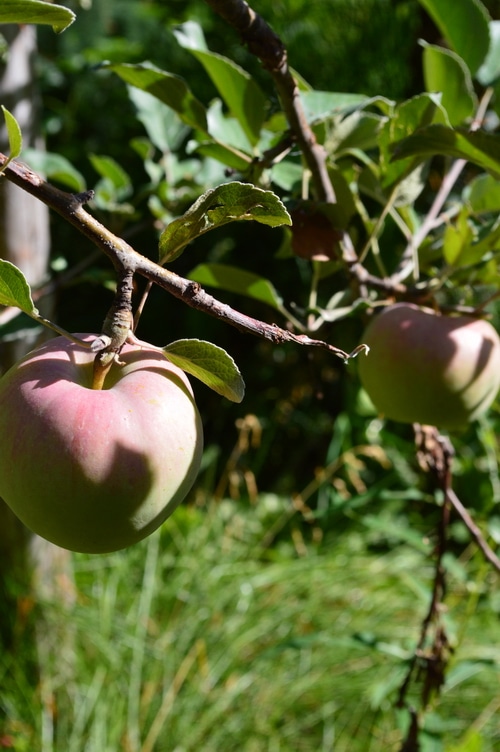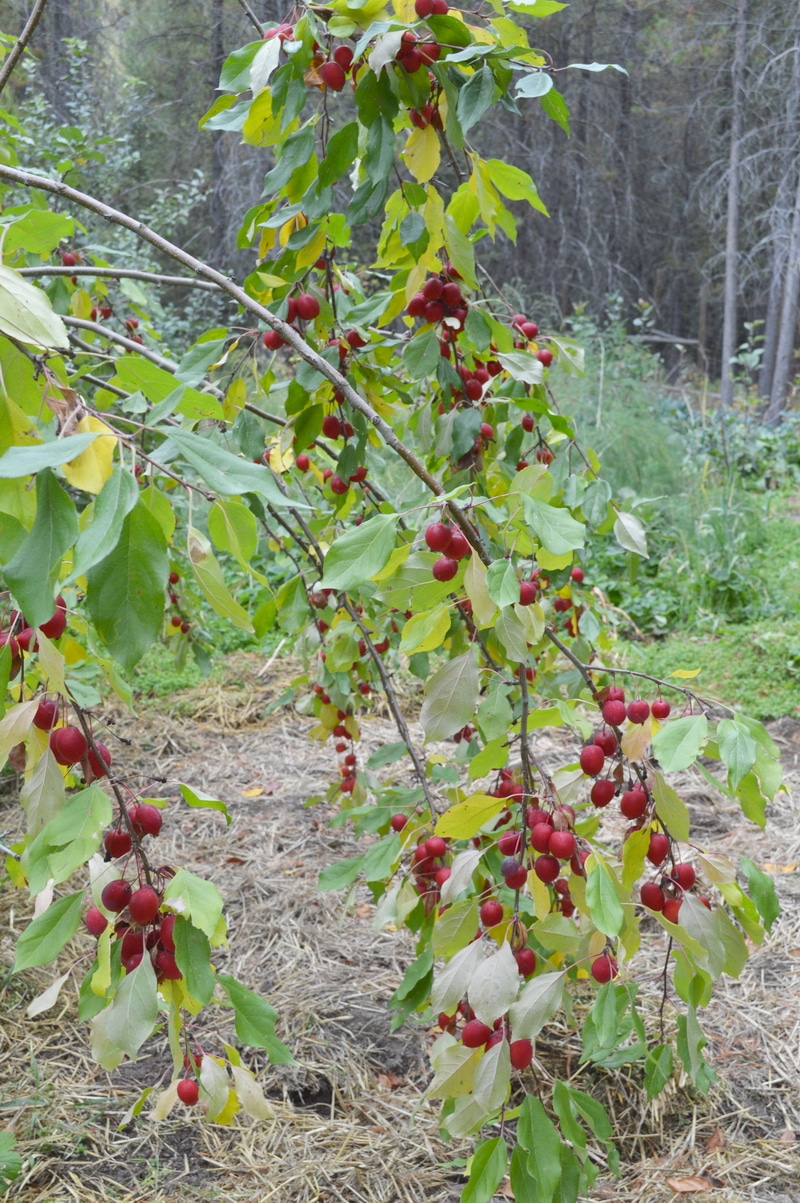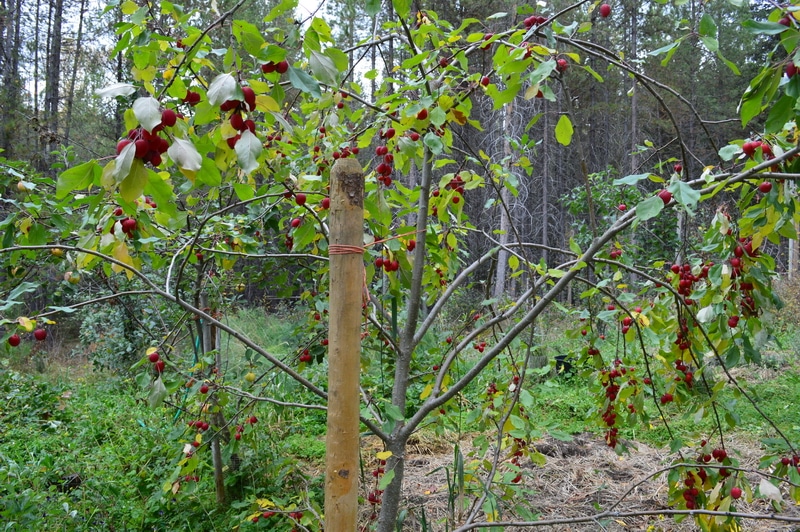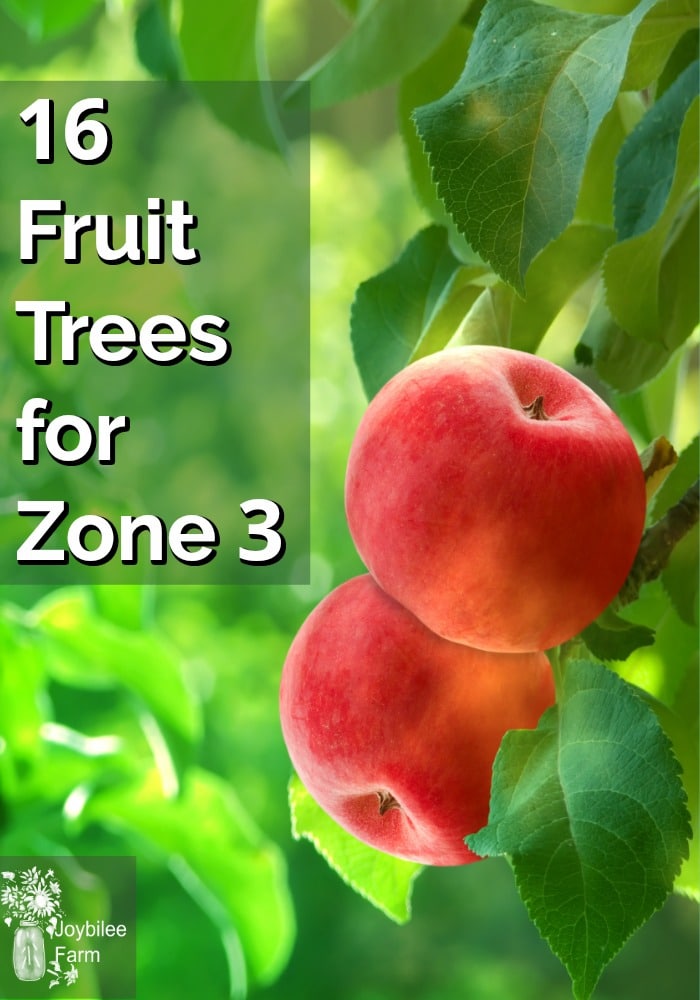16 Fruit Trees for Zone 3 with Great Tasting Fruit!
The fruit you grow yourself will taste better, and be more nutritious than anything that you can buy in the store. While this isn’t an exhaustive list, these are a few of the best tasting fruit available for colder areas. If you don’t plant fruit trees you won’t get any fruit, so plant your trees to begin harvesting amazing homegrown fruit soon.
When flavour matters!
100 years ago scientists at experimental farms all over North America started breeding programs for hardy fruit trees and small fruit that would thrive in the harsh winters of Canada and the Northern USA. It takes as much as 40 years to test cultivars for hardiness and taste. For every fruit that gets accepted thousands more are rejected due to poor yields, lack of flavour or texture, or lack of hardiness.
Once a cultivar passes the experimental stages, it takes even longer to make it a commercial option that can be cultivated for farms and home gardens. Today we get to enjoy the fruit of those labours. Thank you to the hardy orchardists in Minnesota, Manitoba, Saskatchewan, and throughout the colder regions of North America for your hard work.

Will it grow and make fruit where I live?
First a word about “hardiness zones.” Hardiness zones tell you what the coldest expected temperatures are in a region. This isn’t the average winter temperature but rather the extreme cold that your area experiences. It doesn’t give you information about the length of the growing season, the number of frost-free days you can expect or even whether there is enough frost-free season to mature a crop. It also doesn’t offer any information about summer heat units that are required to ripen a crop. You may need to live in a place for a while and keep records to gain this information.
Typically a plant that is hardy to zone 3 can take winter temperatures as low as -40°F/-40°C. A plant that is hardy to zone 2 can take -50°F/-45°C. Zone 4 is winter temperatures between -20°/-30°C and -30°F/-35°C. While you may be able to grow plants that are classified as a zone higher than you have, in a test year you may lose your plants. Typically if you are growing plants that are rated for a zone higher than what you have, you will need to offer extra winter protection to those plants, to get them through the winter.
Can you give the plant what it needs?
When deciding what varieties of fruit and nuts to invest in, you need to have more information than just the plant hardiness zone for your area.
- What is the height and breadth of the mature plant?
- Can you provide it with enough sun and water for its needs?
- How long do they take to begin bearing fruit?
- When does the tree blossom – early spring, mid-season, or late? If you are in an area that gets frost right till June, an early spring blossoming may not have any pollinators out when you need them.
- At what time is the mature fruit ripe? Can it take a frost? Some fruit actually improves after a frost.
Fruit trees often fruit on the wood grown the year before. Winter dieback will kill the fruiting wood and result in crop losses, therefore it is wise to choose fruit varieties that are rated for your hardiness zone.
Does it taste good?
The second criterion when choosing a fruit tree for your land is does the fruit taste good? Will it serve the purpose you need it for, whether fresh eating, preserving, canning, or drying? Often hardy fruit doesn’t have the taste or texture to make it desirable. When you read about a berry plant and it says, “ornamental berries” this means that they are bitter, astringent, dry, mealy, or small and onerous to pick. Many wild berries are considered “ornamental” or “survival use only”. While named cultivars of the same species may have choice berries.
Fruit Trees for your zone 3 garden
Apple Trees for zone 3
Apples (Malus Spp) are the first tree people think of when they want to plant a fruit tree in their yard. There are thousands of different varieties of apples grown in North America, with a few choice cultivars that are hardy in zone 4. While grafting tender cultivars like Golden Delicious on hardy rootstock can improve the survivability of the apple tree itself, fruiting wood of more tender cultivars can be damaged in test winters. On the other hand, apple cultivars with proven hardiness are now available to the home gardener and orchardist. While this isn’t an exhaustive list, these are a few of the best-tasting apples available for colder areas.
Goodland Apple
The Goodland Apple will reach a height of 15 feet with a spread of 12 feet. It is red over pale yellow with some striping. The fruit is 7 to 8 cm, medium to large apple. It is a crisp, juicy apple with medium sweetness. Fruit ripens from mid-August to September. Good for fresh eating, apple sauce, and fruit leather. It stores well. Hardy to zone 3, it bears fruit 3 years after planting.
Norkent Apple
The Norkent apple has the appearance of the Golden Delicious, with a red blush. It has the distinct apple-pear taste of the Golden Delicious. Good for fresh eating and as a cooking apple. Norkent dries well. Its medium to large fruit ripens in early September. The fruit shouldn’t be picked early, as the flavours develop as the apple ripens on the tree. With the Norkent apple, you’ll get fruit a year earlier than other apple cultivars. This is an annual bearing tree. Hardy to zone 2, it bears fruit 3 years after planting.
Harcourt Apple
Harcourt is a University of Alberta introduction. It is a large red apple with a juicy, sweet-tart, taste. The fruit ripens in mid-September. It is good for fresh eating, baking, cider, and juice. It stores well. Hardy to zone 3
Dutchess of Oldenberg
Dutchess is a heritage apple and one of the few apples that will grow true from seed. It is hardy to zone 3. It was once the premier apple of commercial orchards in England. It ripens in early September. Dutchess apples are medium size, with a sweet-tart taste that makes them good for fresh eating, for sauce, and cooking. It is not a long-keeping apple and should be stored for no more than 6 weeks. Hardy to zone 3, it bears fruit 5 years after planting. Dutchess is one of my favourite heritage apple trees and worth searching for.

Dutchess of Oldenburg grafted on Russian Dwarf Rootstock.
Sweet Sixteen
Sweet Sixteen has a very unique taste that is reminiscent of cherries with spice and vanilla cream. The fruit is medium size, crisp, and juicy. It is good for fresh eating and cooking. Harvest in mid-September. Sweet sixteen takes a little longer to bear fruit than other cultivars, often 5 years after planting. Hardy to zone 3b, and worth looking for.

Sweet 16 on hardy Russian rootstock. Very complex and sweet flavour.
All apple trees need a pollinator that blooms at the same time. Crab apples tend to bloom longer than regular apple trees. A crab apple can meet your pollination needs. I grow the Dolgo crab apple, which is hardy to zone 3 – 7. Its tart fruit is large and can be eaten fresh, used in jam, preserves, or apple sauce. It adds a pink tinge to apple sauce and a deep burgundy colour to fruit leather.

Dolgo crab in mid-September and ready to harvest
Prunus
Prunus trees need a pollinator with a similar genetic background. Typical pollinators include Nanking Cherry, Sand Cherry, and Choke Cherry. The bark from the pollinator is useful for treating unproductive coughs and the fruit is usually good for jams and jellies, as well as feeding wildlife.
Cherry Trees for zone 3
“Sour” cherries are the type most adaptable for cold climates. They flower a little later than sweet cherries and so aren’t as damaged by late frosts. Though, the term “sour” refers to the type of tree rather than the taste of the fruit, many of these cultivars have fruit that is sweeter than “sweet” cherries, when fully ripe.

Cupid Cherry
Cupid Cherry is sweet cherry with a shrub habit. It grows only 6 to 8 feet in height on its own root system. The sweet, dark red fruit is 3 to 4 cm and 6.5 grams. This is from the “Romance Series” released in 2004 by the University of Saskatchewan. The tree is self-pollinating but you’ll need either two Cupid Cherries or a second cherry from the Romance Series for pollination. Cupid had the largest cherries of the Romance group. They are deep burgundy when ripe in mid-August. Hardy to zone 2a.
The other cherries in the Romance group include Crimson Passion, Juliet, Romeo, and Valentine. All are hardy to zone 2. All are self-rooted and have a bush habit. The favours are good. The trees are picked more like a Saskatoon bush rather than a cherry tree, allowing for mechanical picking. Of these Juliet, Romeo, and Valentine are sweet and productive. While Crimson passion is a moderate fruiting shrub with larger, sweeter cherries. All these Romance cherries are self-rooted, so damage from winter dieback is minimized. These fruit shrubs are self-pollinating but for best results, at least two trees should be planted.
Evans Cherry
Evans cherry is a sour cherry with small bright red fruit. The tree grows to 12 feet on its own rootstock. The tart cherries are good for juice, drying, and cooking. The cherries ripen in late July. The cherries are on the tart side, with yellow rather than red flesh. Hardy to zone 3. Self-pollinating.
Carmine Jewel Cherry
Carmine Jewel Cherry is a shrub that grows 8 feet with dark purple, small cherries that have small pits and a tart-sweet flavour. The cherry is good for fresh eating and is considered one of the best pie cherries. The productive tree ripens its fruit from late July to early August. Hardy to zone 2. Self-pollinating.
Plum trees for zone 3
Plums are also of the prunus family, like cherries. But most plums require another tree of the same ancestry for pollination. Japanese plums require a Nanking cherry or another Japanese plum for pollination, for instance.

Brookgold Japanese Plum
Hardy to zone 3, Brookgold is a seedling of Japanese plum. The small fruit is gold and freestone. Good for both fresh eating and preserves. The tree grows to 12 feet in height with a spread of 12 feet. It blooms early for ripe fruit in August. Pollinate with other Japanese plums or Nanking cherry.
Toka Plum
Toka is a vigorous Japanese-American hybrid plum. It has red fruit a little bigger than a cherry, and full of fragrance. It is sweet and flavourful. The tree yields moderately well. It’s is a strong pollinator for other plums. It has abundant flowers in spring and pleasing red foliage in the fall garden. Hardy to zone 3.
Waneta Plum
Waneta is the largest of the Japanese hybrid plums. It has been considered the finest American plum for over 100 years. The clingstone fruit is medium-large with red skin and yellow flesh. It has a sweet flavour, suitable for fresh eating and preserves. The tree grows to 12 feet with a spread of 20 feet. Hardy to zone 3.
Apricot Trees for zone 3
Casino™ Apricot
Casino™ grows to 15 feet with a 15-foot spread. A hardy apricot with freestone flesh, with a pink blush, Casino™ ripens in mid-summer. It is good for canning and jam. Self-pollinating but yields will be improved with a Nanking Cherry nearby. Hardy to zone 3.
Westcot Apricot
Like Casino™, Westcot is of the Manchurian/Siberian apricot group. It grows to 16 feet with a spread of 12 feet. Westcot ripens in late summer and has yellow flesh with a pink blush. The fruit is good for canning and jam. Westcot was introduced in 1982 at the Morden Research Station. Self-pollinating but yields will be improved with a Nanking Cherry nearby. Hardy to zone 3.
Pear trees for zone 3
Finding pears that are hardy to zone 3 and still taste good, has been a challenge. Many hardy cultivars are thorny or tasteless, small with a mealy texture. Nursery catalogues might say, “for preserving”. There are a few recent introductions that are worth asking about at your garden centre if you really want to grow pears and you are in the extremes of zone 3. Check out these pear cultivars.
Early Gold Pear
Early Gold is an early maturing pear glossy green-gold fruit, slightly smaller than a bartlett. The tree grows to 20 feet with a spread of 16 feet. Early Gold is suitable for fresh eating, canning, and preserves. Hardy to zone 3. Cross-pollinate with another pear for consistent yields.
Golden Spice Pear
Golden spice is a thorny pear with small golden fruit that turns red when ripe, in the late fall. The fruit is suitable for preserves and canning, though not recommended for fresh eating. The tree reaches a height of 23 feet with a spread of 16 feet. Hardy to zone 3. Cross-pollinate with another pear for consistent yields.

How long before I see fruit?
There are a lot of variables in fruit yields depending on growing conditions. Sweet Cherries seem to take the longest to yield, requiring up to 7 years after planting before the trees begin to bear well. Whereas, sour cherries and apricots may begin to bear fruit in 3 to 5 years. All the cherries named in this article are in the “sour cherry class”. Plum trees take 3 to 6 years to bear. Apples average 3 to 5 years to bear. Seedlings and whips grafted on hardy rootstock can take 10 to 12 years before they begin to bear.
Assuming you have the correct pollinator tree for the fruit that you have, your fruit trees should be bearing some fruit within 5 years of planting. Once they start to bear, yields will increase annually. But if you don’t plant fruit trees you won’t get any fruit. So pick your cultivars, fence your orchard, and plant your trees so that you can begin harvesting amazing homegrown fruit soon. The fruit you grow yourself will taste better, and be more nutritious than anything that you can buy in the store.
Preserving your orchard fruit
And while you are waiting for your trees to arrive start gathering your supplies for preserving that fruitful abundance.
How to make apple cider vinegar
Your turn:
If you could only grow one fruit tree in your garden what would you choose?



that would be fine.
How far away do you need the Japanese plum trees to be planted for the pollination to be effective?
I am thinking of planting one in my front yard and one in my back yard. Will this work out or do they need to be closer? My yard is not large.
There’s are several possibilities. It could be that you don’t have the correct pollinator for your particular varieties of plum — Japanese plums need another japanese plum of a different variety. Nanking cherries also work as a cross pollinator on Japanese plum. American plums need another American plum to set fruit. Plum trees are a little more complicated than apple trees for cross pollination. Another issue might be that your trees need more fertilizer or water. Usually that is a fertilizer that is higher in bone meal or phosphate rock. Another issue could be that you need more pollinators or that the temperatures were too cold for the pollen to set when the trees were in bloom. Often trees can take up to 3 years before they produce their first crop of fruit. The fact that you already have blossoms is a good sign.
I have 3kind of plum i planted it last year and there is lot of flowers firts and then gone the plum has small fruits but only one left is this normal for the firts year of having fruit ? We are located at zone3
Please help me out so I understand and make sure I am understanding this. You purchased plants with Russian Root stock on them, or did you graft the cherries trees with Russian Root stock?